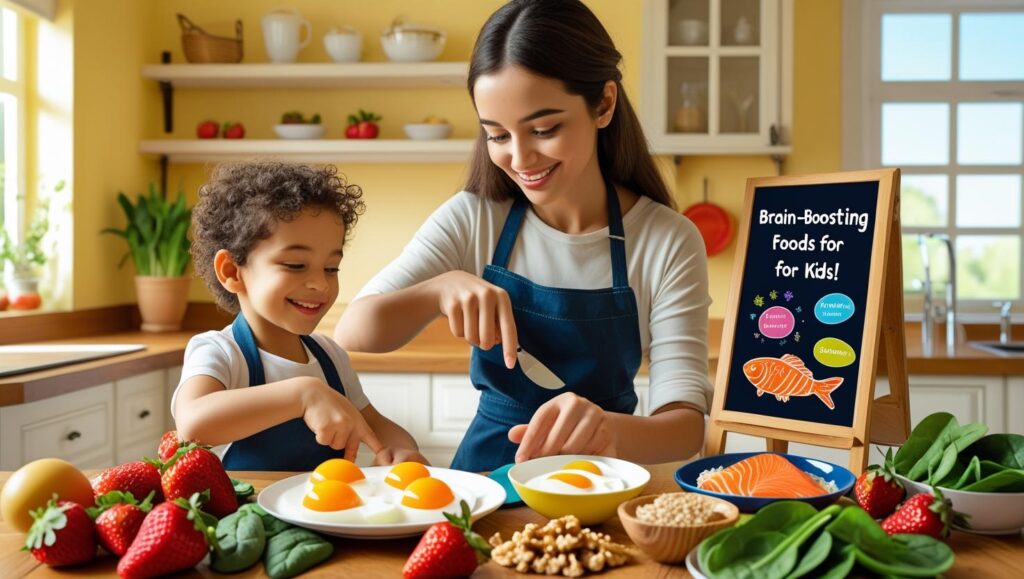A child’s brain develops rapidly during the first few years of life, forming the foundation for learning, memory, and cognitive abilities. Proper nutrition plays a crucial role in supporting this growth, enhancing focus, problem-solving skills, and emotional regulation.
As parents, ensuring that your child eats brain-boosting foods can set them up for academic success and long-term mental health. In this article, we’ll explore the best foods for child brain development, backed by science, and provide practical tips for incorporating them into your child’s diet.

Why Nutrition Matters for Brain Development
The brain is made up of fats, proteins, water, and micronutrients, all of which require a steady supply of high-quality food. Key nutrients that support brain health include:
- Omega-3 fatty acids(DHA & EPA) – Essential for neuron formation and cognitive function.
- Choline– Supports memory and learning.
- Iron– Crucial for oxygen transport to the brain.
- Zinc– Enhances focus and neurotransmitter function.
- Antioxidants(Vitamins C & E) – Protect brain cells from damage.
- B Vitamins– Aid in energy production and neurotransmitter synthesis.
A deficiency in any of these nutrients can lead to developmental delays, poor concentration, and behavioral issues.
Top 12 Brain-Boosting Foods for Kids
1. Fatty Fish (Salmon, Sardines, Mackerel)
Fatty fish are rich inomega-3 fatty acids (DHA and EPA), which are critical for brain cell structure and function. Studies show that children with higher omega-3 intake have better memory, focus, and problem-solving skills.
How to Serve:
- Grilled salmon with veggies
- Fish tacos with whole-grain tortillas
- Sardine or tuna sandwiches
2. Eggs
Eggs are packed withcholine, a nutrient that supports memory and brain development. They also contain protein and B vitamins, which help with energy and focus.
How to Serve:
- Scrambled eggs with spinach
- Hard-boiled eggs as a snack
- Omelets with cheese and veggies
3. Berries (Blueberries, Strawberries, Blackberries)
Berries are loaded withantioxidants, which protect the brain from oxidative stress. They also improve communication between brain cells and enhance learning.
How to Serve:
- Mixed berry smoothies
- Yogurt with fresh berries
- Berry-topped oatmeal
4. Nuts and Seeds (Walnuts, Almonds, Chia, Flaxseeds)
Nuts and seeds providehealthy fats, vitamin E, and zinc, all of which support cognitive function. Walnuts, in particular, resemble the brain and are high in DHA-like omega-3s.
How to Serve:
- Almond butter on whole-grain toast
- Trail mix with nuts and dried fruit
- Chia pudding for breakfast
5. Leafy Greens (Spinach, Kale, Broccoli)

Leafy greens are rich infolate, iron, and vitamin K, which help with brain cell growth and neurotransmitter function. Iron deficiency is linked to poor attention spans in children.
How to Serve:
- Spinach in smoothies (hidden!)
- Steamed broccoli with cheese
- Kale chips as a crunchy snack
6. Whole Grains (Oats, Quinoa, Brown Rice)
Whole grains providesteady glucose, the brain’s primary energy source. They also contain B vitamins, which improve focus and reduce brain fog.
How to Serve:
- Oatmeal with honey and nuts
- Quinoa salad with veggies
- Whole-grain pasta dishes
7. Greek Yogurt
Greek yogurt is high inprotein and probiotics, which support gut health—a key factor in brain function due to the gut-brain connection. It also contains iodine, essential for cognitive development.
How to Serve:
- Yogurt parfaits with granola
- Frozen yogurt popsicles
- Smoothies with Greek yogurt
8. Lean Meat (Chicken, Turkey, Lean Beef)
Lean meats are excellent sources ofiron and zinc, which help with focus and prevent cognitive decline. Iron deficiency is a leading cause of learning difficulties in children.
How to Serve:
- Grilled chicken strips
- Turkey meatballs
- Beef stir-fry with veggies
9. Beans and Lentils
Beans provideprotein, fiber, iron, and magnesium, which help stabilize energy levels and improve concentration.
How to Serve:
- Hummus with veggie sticks
- Lentil soup
- Black bean tacos
10. Avocados
Avocados are packed withhealthy monounsaturated fats, which support blood flow to the brain and enhance cognitive function.
How to Serve:
- Avocado toast
- Guacamole with whole-grain chips
- Sliced avocado in salads
11. Dark Chocolate (70% Cocoa or Higher)

Dark chocolate containsflavonoids and caffeine, which boost memory and mood. It also has antioxidants that protect brain cells.
How to Serve:
- Small squares as a treat
- Chocolate-dipped strawberries
- Cocoa powder in smoothies
12. Water
Dehydration leads tofatigue, poor concentration, and irritability. Keeping kids hydrated ensures optimal brain function.
How to Encourage:
- Infused water with fruits
- Fun water bottles with straws
- Herbal iced teas
Foods to Avoid for Optimal Brain Health
While some foods enhance brain function, others can hinder it. Limit or avoid:
- Sugary snacks & sodas– Cause energy crashes and reduce focus.
- Processed foods (chips, fast food)– Contain unhealthy fats and additives.
- Artificial food dyes– Linked to hyperactivity in some children.
- Excessive caffeine– Can lead to anxiety and sleep disturbances.
Tips for Encouraging Healthy Eating Habits
- Lead by Example– Kids mimic parents, so eat brain-boosting foods together.
- Make Meals Fun– Use colorful plates, creative shapes, and dips.
- Involve Kids in Cooking– They’re more likely to eat what they help prepare.
- Sneak in Nutrients– Blend veggies into sauces or smoothies.
- Be Patient– It can take multiple exposures before a child accepts a new food.
Final Thoughts
A well-balanced diet rich in omega-3s, antioxidants, vitamins, and minerals is essential for a child’s brain development. By incorporating these brain-boosting foods into daily meals, parents can support their child’s cognitive growth, memory, and overall mental well-being.
Small, consistent changes in diet can make a big difference in a child’s ability to learn, focus, and thrive. Start with one or two foods from this list and gradually introduce more for long-term benefits.
Would you like a sample meal plan for a week? Let me know in the comments!
![]()






